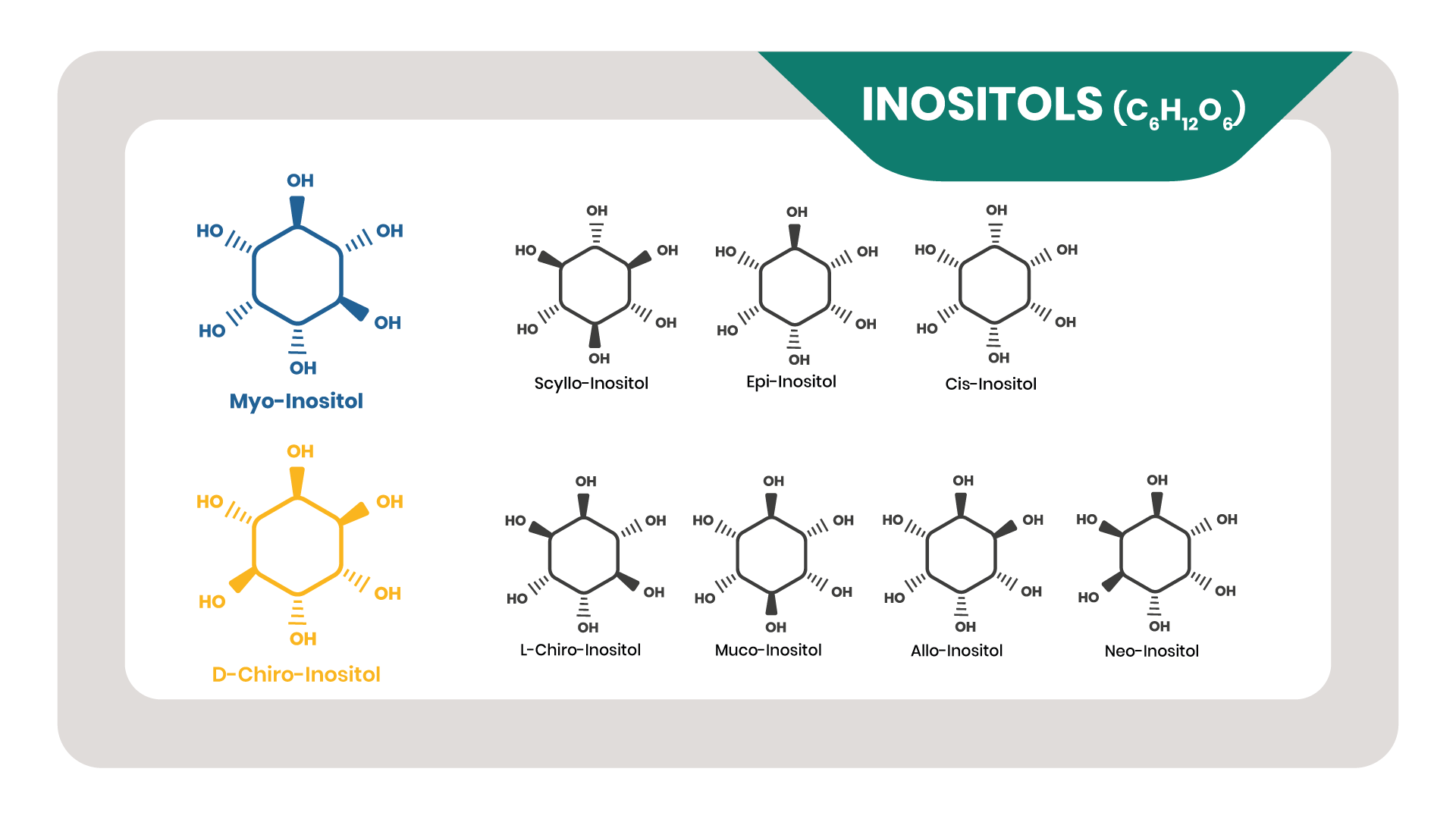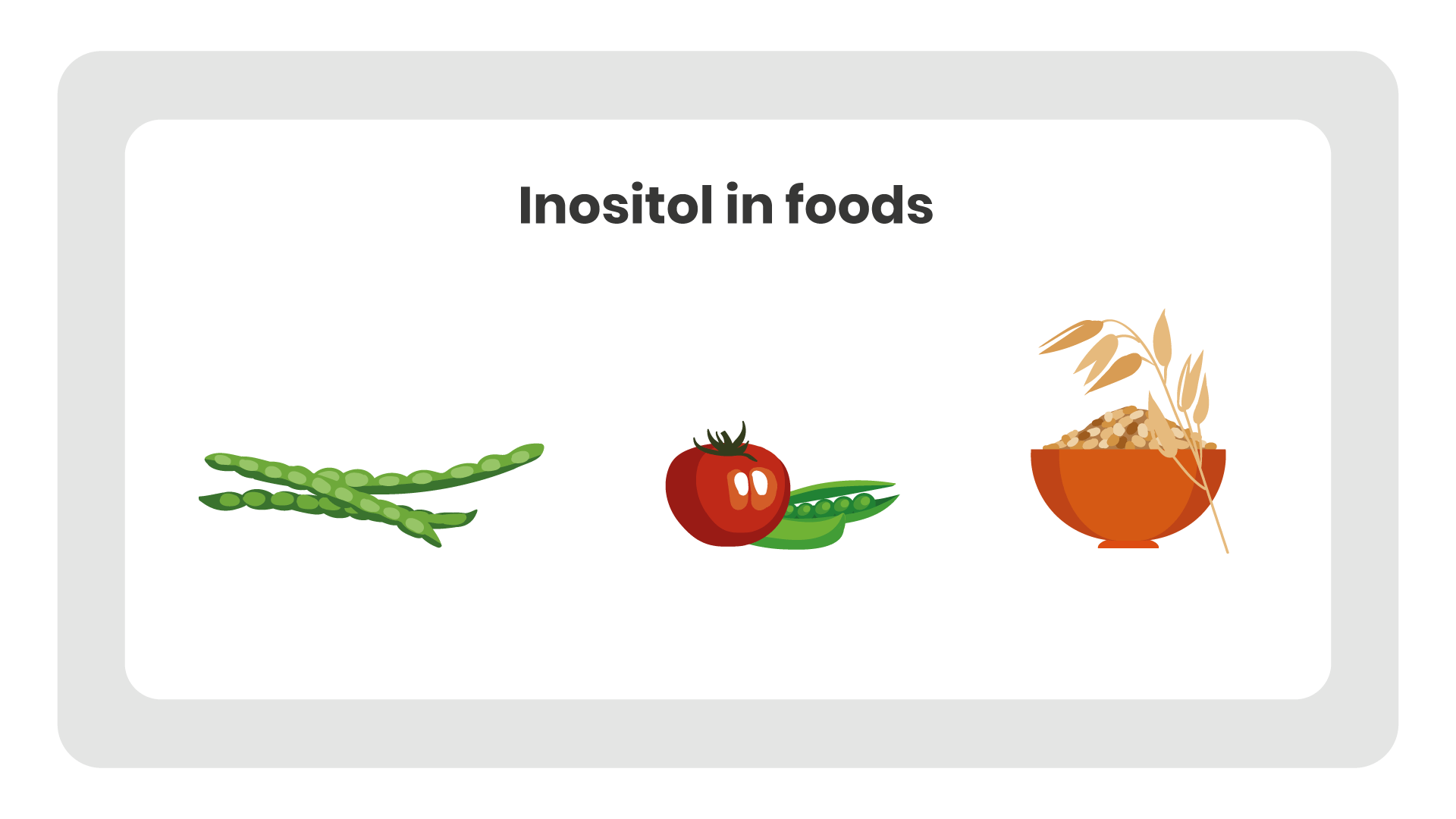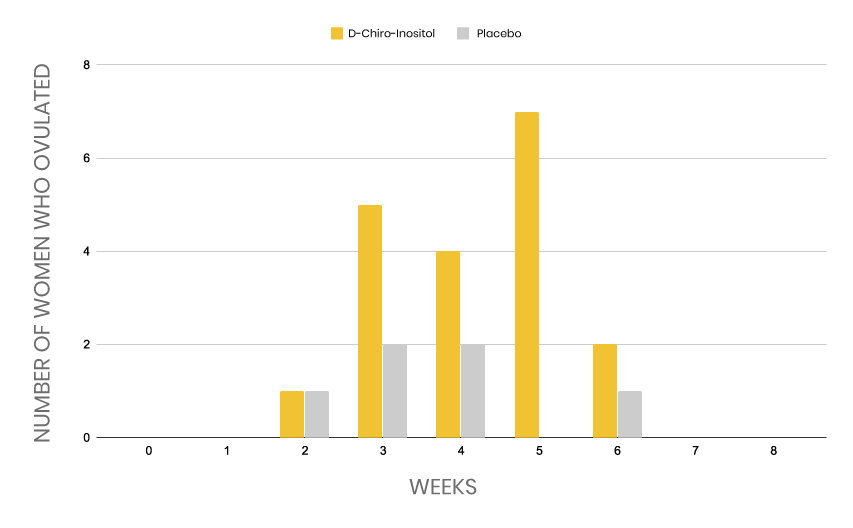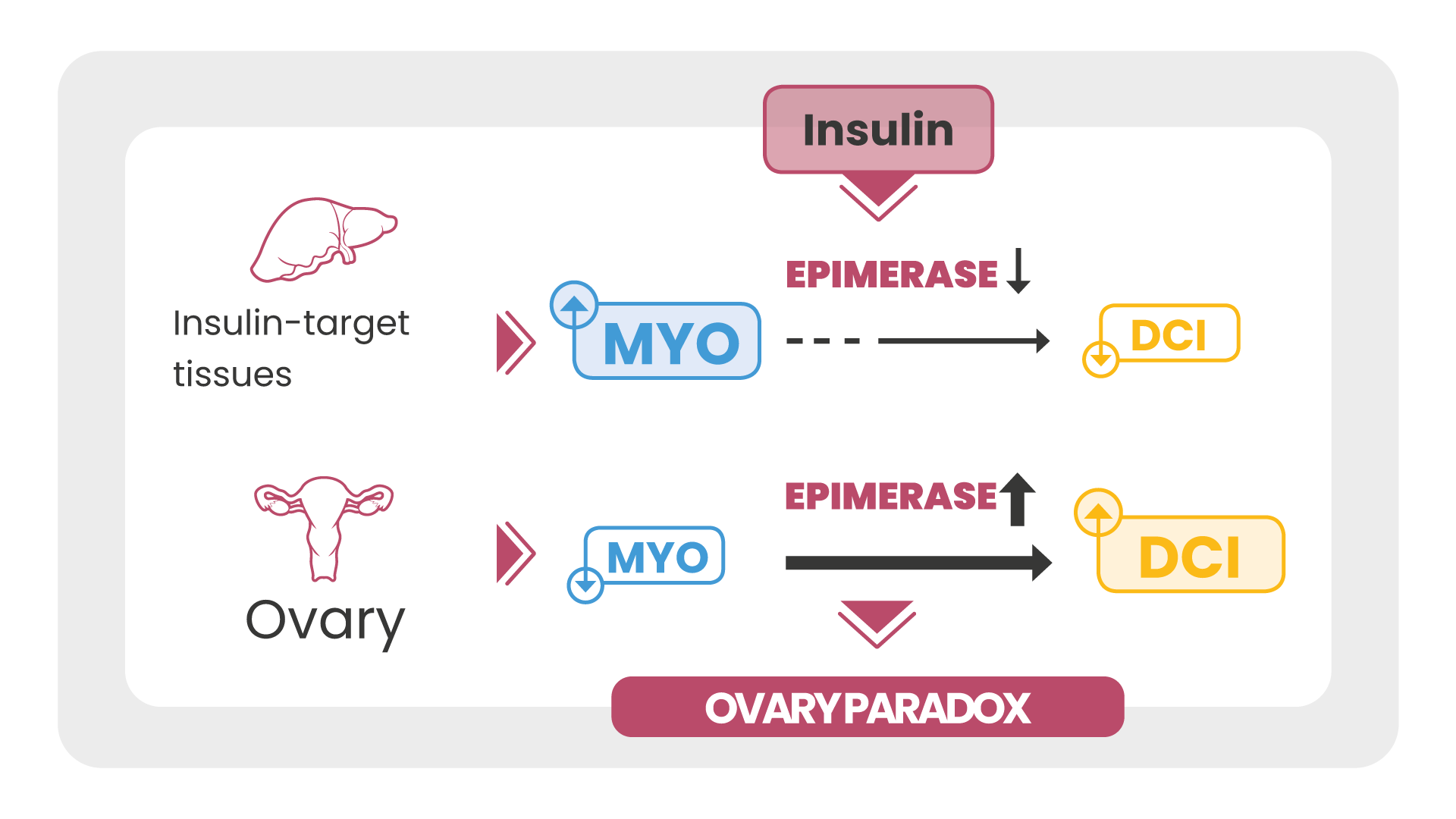Introduction
In the context of the study of inositols and their use in obstetric-gynecological clinical practice, research on D-chiro inositol represented a starting point that paved the way for new therapeutic approaches for various pathologies. Among these is PCOS or polycystic ovary syndrome.
But what are the results of the studies conducted on this molecule? And how did this influence subsequent research?
On this page we try to answer these questions, evaluating the pros and cons of the use of D-chiro inositol right from the syndrome and clarifying the functions that the two main inositols, Myo-inositol and D-chiro, perform in the body.
What is D-chiro inositol
D-chiro-inositol (commonly abbreviated DCI) is a member of a group of molecules collectively called inositols.
Inositol contains 9 isomers with different biological functions, and it is for this reason that it is more correct to talk about “inositols” in the plural.
Among these, myo-inositol and d-chiro-inositol, natural substances, play a fundamental role, although different for the body.

Where can we find D-chiro inositol
In the body, D-chiro-inositol is found in high concentrations in the tissues that store glycogen and that need to save energy: fat and liver!
Overall, however, d-chiro inositol is less abundant in nature than myo-inositol which makes up about 99% of the intracellular pool of inositols.
Finally, D-chiro-inositol is generated from myo-inositol itself: a part of the latter is in fact converted into d-chiro by the epimerase enzyme.
What is it for?
As anticipated, myo and d-chiro inositol perform important functions in the body.
Specifically, D-chiro:
- mediates the action of insulin;
- it is involved in the synthesis of insulin-dependent androgens;
- promotes glucose storage;
- acts as an aromatase modulator [1].
Inositol in food
Inositol is widespread in vegetables: green beans, peas, asparagus and carrots are rich in it.
We can find it fruits such as pears, cherries, apples and tomatoes. Inositol is also present in oats, corn and cereals as a component of lecithins.

The history of D-chiro inositol
It is difficult to talk about the history of D-chiro-inositol without talking about PCOS or polycystic ovary syndrome.
It is a multifactorial condition that affects between 5%-10% of women of reproductive age. The syndrome is known to be the leading cause of anovulatory infertility due to menstrual cycle alterations.
Since 1980, PCOS has been known to be associated with insulin resistance [2].
To learn more, visit: Polycystic ovary syndrome
The history of inositols (myo and D-chiro) stems precisely from the search for a treatment for PCOS, and has its roots in the use of myo and D-chiro in type 2 diabetes.
In 1993 Larner showed that the administration of D-chiro-inositol phosphoglycans reduced hyperglycemia, confirming the hypothesis that this molecule could act as the “second messenger” of the insulin signaling [3].
Scientific research on D-chiro
In 1999 a group of researchers led by Nestler first experimented and reported the efficacy of D-chiro-inositol in the treatment of a group of 22 obese PCOS women (1200 mg of DCI for 6-8 weeks). The results showed that:
- 10 out of 22 women ovulated after 4 weeks of treatment;
- another 9 women after 8 weeks
The authors also reported an improvement of insulin sensitivity and a reduction of serum androgens.

However 2008 represents a real watershed in the history of inositols and in the treatment of polycystic ovary syndrome. In fact, a new Cheang study was published with the administration of higher dosages of D-chiro inositol and for an extended period of time (2400 mg for 8 weeks) that did not confirm the results previously obtained. The study was stopped and abandoned prematurely [4].
Could high dosages and long-term administration be the cause of the failure results?
The answer to the question is affirmative, as clarified by the authors themselves [4] and gave the impetus to a group of Italian researchers, who had already completed studies on myo-inositol in PCOS since 2003, to continue their research on the use of this molecule and to clarify the role of d-chiro-inositol [5].
As anticipated, in 2003 in Italy very positive first results were verified with the administration of myo alone in PCOS women for 6 months 2 times a day. Myo-inositol was able to restore spontaneous ovulation and fertility [5].
To date, there are numerous scientific studies demonstrating the effectiveness of myo-inositol or myo-inositol combined with D-chiro in PCOS women.
To learn more, read also: The benefits of myo-inositol in PCOS
Myo and D-chiro in PCOS: comparison of inositols
We said at the beginning of this article that myo-inositol and d-chiro inositol are both second messengers of insulin signal, but with different functions.
Despite the similarities, the two inositols play different roles in the body and their distribution in the tissues is also different.
- Myo-inositol is the second messenger of FSH, the follicle stimulating hormone [6]
- D-chiro-inositol acts as an aromatase modulator [7]
It is precisely the different physiological activities and the different presence in the tissues of myo and D-chiro inositol that dictate the dosages and times of administration of both inositols.
With regard the PCOS treatment what is important to know is that in women suffering from this condition, at ovarian level, there is a lack of myo-inositol and an excess of d-chiro.
This imbalance is due to the excessive activity of an enzyme, the epimerase which depends on insulin and which regulates the conversion of myo-inositol into d-chiro-inositol. The insulin resistance of PCOS women generates hyperinsulinemia. The body’s cells are practically “deaf” to the insulin signal and the body responds by producing it more and more

Therefore, the ovary becomes rich in D-chiro and deficient in myo-inositol, with a negative effect on the FSH signal and on the oocyte quality [8].
The paradox of D-chiro-inositol in PCOS
The discovery of ovarian excess d-chiro-inositol, known as the paradox of DCI in the ovary, or “ovarian paradox”, explains the negative results documented by the 2008 studies resulting from high d-chiro administrations for a long term on PCOS women.
In fact, if the ovary of PCOS women is rich in d-chiro, why administering excessive doses of d-chiro-inositol?
On the contrary, according to several studies, it is the balance between myo and d-chiro to be restored with a treatment that balances myo and d-chiro in the physiological ratio.
In 2017 the review “Can high levels of D-chiro-inositol in follicular fluid exert detrimental effects on blastocyst quality?”, Published in the European review for medical and pharmacological sciences confirms that excessive levels of d-chiro-inositol in the follicular fluid have a negative effect on blastocysts quality [9].
In fact, D-chiro inositol is able to increase testosterone levels (male hormones) already elevated in PCOS women, through two different ways:
- in theca cells as an insulin mediator [10]
- and in granulosa cells as an aromatase modulator [7]
These findings also explains why testosterone levels are so high in PCOS women compared to healthy women.
D-chiro inositol: how, how much and why?
Partendo dal paradosso ovarico e dallo squilibrio tra myo e d-chiro a livello ovarico nelle donne PCOS, studiosi e ricercatori si sono interrogati se un possibile trattamento non dovesse tenere conto della necessità di ripristinare i livelli fisiologici tra i due inositoli nel fluido follicolare.
Uno studio clinico condotto su 46 donne PCOS obese è stata somministrata una terapia combinata di Myo e D-chiro inositolo nel rapporto 40:1 (in altre parole un trattamento prevalentemente a base di myo-inoitolo e solo in piccola parte di d-chiro) per 6 mesi.
Gli autori dello studio hanno osservato che:
- la sensibilità all’insulina era migliorata;
- miglioramento dell’ovulazione;
- una diminuzione di LH e testosterone libero;
- una riduzione significativa dell’HOMA index.
In breve, lo studio ha dimostrato un miglioramento dei parametri ormonali, metabolici e dell’ovulazione senza effetti collaterali [11] in soli 3 mesi di trattamento a base di myo e d-chiro-inositolo nel rapporto 40:1.
Per approfondire questo argomento vai alla sezione: Myo e D-chiro 40:1
Sources
[1] Sacchi S, Marinaro F, Tondelli D, Lui J, Xella S, Marsella T, et al. Modulation of gonadotrophin induced steroidogenic enzymes in granulosa cells by d-chiroinositol. Reproductive biology and endocrinology: RB&E. 2016;14(1):52.
[2] Goodarzi M, et al. Polycystic ovary syndrome: Etiology, pathogenesis and diagnosis.” Nat Rev Endocrinol, 2011.;7(4):219–231.
[3] Heimark D, McAllister J, Larner J. Decreased myo-inositol to chiro-inositol (M/C) ratios and increased M/C epimerase activity in PCOS theca cells demonstrate increased insulin sensitivity compared to controls. Endocr J. 2014;61(2):111-7.
[4] Inositoli: storia e personaggi di una terapia efficace, V. Unfer, Minerva Medica, Int J. Endocrinol Vittorio Unfer, John E. Nestler, Zdravko A. Kamenov, Nikos Prapas, and Fabio Facchinetti, 2014
[5] Gerli S, Papaleo E, Ferrari A, Di Renzo GC. Randomized, double blind placebo-controlled trial: effects of myo-inositol on ovarian function and metabolic factors in women with PCOS. European review for medical and pharmacological sciences. 2007;11(5):347-54.
[6] Antonio Simone Laganà, Inositol in Polycystic Ovary Syndrome: Restoring Fertility through a Pathophysiology- Based Approach, Cell Press, 4, 2018
[7] Nestler JE, Jakubowicz DJ, de Vargas AF, Brik C, Quintero N, Medina F. Insulin stimulates testosterone biosynthesis by human thecal cells from women with polycystic ovary syndrome by activating its own receptor and using inositolglycan mediators as the signal transduction system. The Journal of clinical endocrinology and metabolism. 1998;83(6):2001-5.
[8] Unfer V, Carlomagno G, Papaleo E, Vailati S, Candiani M, Baillargeon JP. Hyperinsulinemia Alters Myoinositol to d-chiroinositol Ratio in the Follicular Fluid of Patients With PCOS. Reprod Sci. 2014;21(7):854-8.
[9] Ravanos K, Monastra G, Pavlidou T, Goudakou M, Prapas N. Can high levels of D-chiro-inositol in follicular fluid exert detrimental effects on blastocyst quality? European review for medical and pharmacological sciences. 2017;21(23):5491-8.
[10] Sacchi S, Marinaro F, Tondelli D, Lui J, Xella S, Marsella T, et al. Modulation of gonadotrophin induced steroidogenic enzymes in granulosa cells by d-chiroinositol. Reproductive biology and endocrinology : RB&E. 2016;14(1):52.
[11] Benelli E, Del Ghianda S, Di Cosmo C, Tonacchera M. A Combined Therapy with Myo-Inositol and D-Chiro-Inositol Improves Endocrine Parameters and Insulin Resistance in PCOS Young Overweight Women. Int J Endocrinol. 2016;2016:3204083.
Other topics that may interest you
Myo-inositol
40:1
Alpha-lactalbumin
PCOS
Overweight